Related Research Articles

Shahab-ud-din Muhammad Khurram, better known by his regnal name, Shah Jahan, was the fifth Mughal emperor, and reigned from 1628 to 1658. Under his reign, the Mughal Empire reached the peak of its cultural glory. Although an able military commander, Shah Jahan is best remembered for his architectural achievements. His reign ushered in the golden age of Mughal architecture. Shah Jahan commissioned many monuments, the best known of which is the Taj Mahal in Agra, in which is entombed his favourite wife, Mumtaz Mahal. His relationship with Mumtaz Mahal has been heavily adapted into Indian art, literature and cinema. He owned the royal treasury and several precious stones such as the Kohinoor and has thus often been regarded as the wealthiest Indian in history.

The Taj Mahal, originally the Rauza-i-munawwara is an ivory-white marble mausoleum on the southern bank of the river Yamuna in the Indian city of Agra. It was commissioned in 1632 by the Mughal emperor Shah Jahan to house the tomb of his favourite wife, Mumtaz Mahal; it also houses the tomb of Shah Jahan himself. The tomb is the centrepiece of a 17-hectare (42-acre) complex, which includes a mosque and a guest house, and is set in formal gardens bounded on three sides by a crenellated wall.

Agra is a city on the banks of the Yamuna river in the Indian state of Uttar Pradesh, about 210 km south of the national capital New Delhi. With a population of roughly 1.6 million, Agra is the fourth-most populous city in Uttar Pradesh and twenty-third most populous city in India.

Mumtaz Mahal was the Empress consort of the Mughal Empire from 19 January 1628 to 17 June 1631 as the chief consort of the Mughal emperor Shah Jahan. The Taj Mahal in Agra, often cited as one of the Wonders of the World, was commissioned by her husband to act as her tomb.

Nur Jahan was the twentieth wife of the Mughal emperor Jahangir.
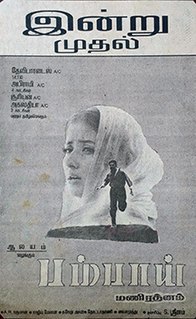
Bombay is a 1995 Indian Tamil-language romantic drama film written and directed by Mani Ratnam, starring Arvind Swami and Manisha Koirala in the lead. The film tells the story of an inter-religious family in Bombay before and during the Bombay riots, which took place between December 1992 and January 1993 after the demolition of the Babri Masjid led to religious tensions between Hindu and Muslim communities. It is the second in Ratnam's trilogy of films that depict human relationships against a background of Indian politics, including Roja (1992) and Dil Se.. (1998). The film was dubbed in Hindi, Telugu and Malayalam with the same title.
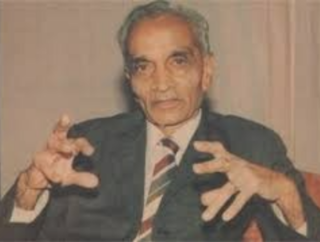
Purushottam Nagesh Oak was a historical revisionist from India.

Mouna Ragam is a 1986 Indian Tamil-language romantic drama film written and directed by Mani Ratnam, and produced by G. Venkateswaran. The film stars Mohan and Revathi, with Karthik, V. K. Ramasamy, Ra. Sankaran, Bhaskar, Kanchana, Vani, Kalaiselvi and Sonia in supporting roles. It narrates the life of Divya (Revathi), a free-spirited college girl who is forced into an arranged marriage with Chandrakumar (Mohan) by her father. Divya, secretly mourning her former lover Manohar (Karthik) who was shot dead, did not want to be married. The story follows Divya's inner conflict between holding onto her past and coming to terms with the present and making a life with Chandrakumar.
Abdul Hamid Lahori was a traveller and historian during the period of Mughal Emperor Shah Jahan who later became a court historian of Shah Jahan. He wrote the book Padshahnama, about the reign of Shah Jahan. He has described Shah Jahan's life and activities during the first twenty years of his reign in this book in great detail Infirmities of old age prevented him from proceeding with the Third decade which was then chronicled by Waris, a historian.
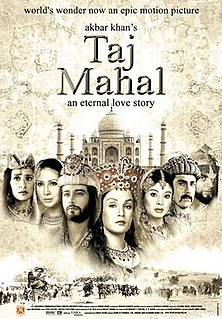
Taj Mahal: An Eternal Love Story is a 2005 Indian historical drama film directed by Akbar Khan. The movie starred Kabir Bedi, Sonya Jehan, Manisha Koirala, Arbaaz Khan, Vaquar Shaikh, Rahil Azam and Pooja Batra in the title roles. The movie was released on 18 November in India.

Parminder Kaur Nagra is an English film and television actress. She is known for playing Jess Bhamra in the film Bend It Like Beckham (2002) and Dr. Neela Rasgotra in the NBC medical drama series ER from 2003 to 2009. She has had several other major television roles, including a starring role as Meera Malik in the NBC crime drama series The Blacklist for season one and a recurring role on the ABC/Marvel Television series Agents of S.H.I.E.L.D. as Ellen Nadeer for season four.
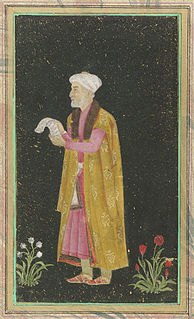
Mirza Ghiyas Beg, also known by his title of I'timad-ud-Daulah, was an important Persian official in the Mughal empire, whose children served as wives, mothers, and generals of the Mughal emperors.
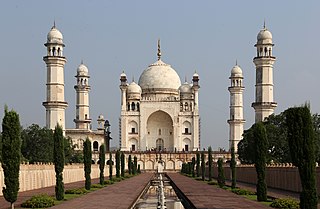
The Bibi Ka Maqbara is a tomb located in Aurangabad, Maharashtra, India. It was commissioned in 1660 by the Mughal emperor Aurangzeb in the memory of his first and chief wife Dilras Banu Begum and is considered to be a symbol of Aurangzeb's 'conjugal fidelity'. It bears a striking resemblance to the Taj Mahal, the mausoleum of Aurangzeb's mother, Mumtaz Mahal. Aurangzeb was not much interested in architecture though he had commissioned the small, but elegant, Pearl Mosque at Delhi. Bibi Ka Maqbara is the second largest structure that Aurangzeb has built, the largest being the Badshahi Mosque.
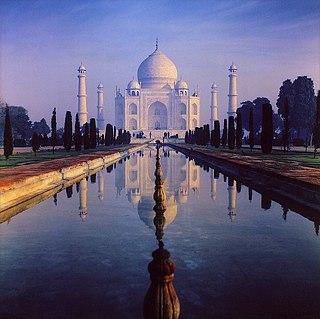
The Taj Mahal represents the finest and most sophisticated example of Indo-Islamic architecture. Its origins lie in the moving circumstances of its commission and the culture and history of an Islamic Mughal empire's rule of large parts of India. The distraught Mughal Emperor Shah Jahan commissioned the project upon the death of one of his favorite wives Mumtaz Mahal.

Baradwaj Rangan is an Indian film critic, writer, and formerly the deputy editor of The Hindu. He later became a senior editor of Film Companion. Rangan won the National Film Award for Best Film Critic in 2006. Before joining The Hindu, Rangan wrote for The New Indian Express. He has also authored two books, worked as a screenwriter, and is a teacher at the Asian College of Journalism, Chennai.

Taj Mahal is a 1963 film based on the historical legend of the Mughal emperor Shah Jahan, who built the Taj Mahal in fond remembrance and as a tomb for his beloved wife Mumtaz Mahal.

Jagat Gosain was a consort of the fourth Mughal emperor Jahangir and the mother of his successor, Shah Jahan. Her title means 'Mistress of the World' and 'Lady Spiritual Guide of the World'.
C. V. Kumar is an Indian Tamil film producer, director and distributor who heads the production studio Thirukumaran Entertainment. Known for producing innovative and critically acclaimed films, Kumar has also primarily introduced new talent into the film industry in terms of actors and technicians. His first three films, Attakathi, Pizza and Soodhu Kavvum won critical acclaim as well as bringing in revenue of over ₹50 crore (US$7.0 million). After producing successful films, Kumar began work on his first directorial venture in 2014.

Persian Inscriptions on Indian Monuments is a book written in Persian by Dr Ali Asghar Hekmat E Shirazi and published in 1956 and 1958 and 2013. new edition contains the Persian texts of more than 200 epigraphical inscriptions found on historical monuments in India, many of which are currently listed as national heritage sites or registered as UNESCO world heritage, published in Persian; an English edition is also being printed.
Sati-un-Nissa, also known as Sati-un-nisa, Sati al-Nisa Khanam, Sati-al-Nesāʾ was an Indo-Persian physician, a lady-in-waiting to Mumtaz Mahal, mahaldar of Shah Jahan, and tutor to their daughters Jahanara Begum and Gauhar Ara Begum.
References
- ↑ Palekar, Amol. Quality Gets Topmost Billing: Palekar, Indian Express, 10 September 1998.
- ↑ Murari, Tim. The 'Bend It Like Beckham' Girl, The Hindu, 28 July 2002.
- ↑ Us Salam, Zia. The Strategist Returns, The Hindu, 5 July 2014.
- 1 2 Rangan, Baradwaj. Write Connections, Baradwaj Rangan Blog, 24 July 2007.
- ↑ Badrinath, Tulsi. There Are Bits of me Scattered in These Books, The Hindu, 5 May 2012.
- ↑ "Writing is a Marathon". The Hindu . 3 February 2008. Retrieved 26 June 2018.